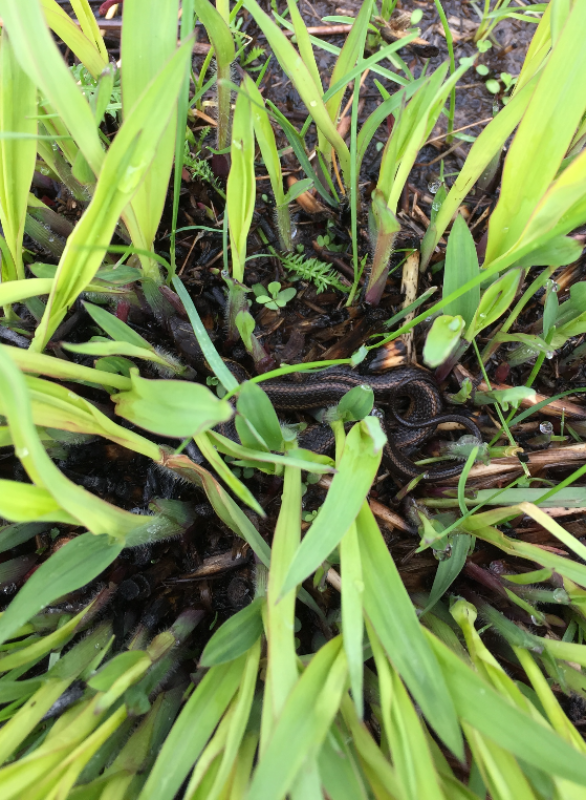Middleton has a lot of great conservation efforts going on, and I’m grateful for Pheasant Branch Conservancy introducing me to those efforts. Kromrey Middle School is well known locally for its green school initiatives. Several years ago some rain gardens were planted, but they had been neglected since that time until last fall when a class had weeded them. Rain gardens aren’t maintenance-free, and they require work to keep them free of invasives and other unwanted plants. The plan this spring has been to get rid of the invasive plants, like crown vetch and reed canary grass, and then they will reseed the gardens later. The first session involved helping out the students with measuring their plots in square feet and helping them identify what species they might want to keep. I did this on April 30th, and I was supposed to help on May 7th, but that was the day after my very graceful ankle spraining incident.
I got back on that field trip horse this week to help out another school group from Glacier Creek Middle School at Orchid Heights Park, which rests along the Bock Community Forest and Pheasant Branch Conservancy. Today’s initial plan was to rotate groups through three different stations that involved learning about human impacts on the Conservancy, biodiversity in quadrats, and a journaling exercise. However, the weather wasn’t cooperating earlier in the day, so we cut out the journaling exercise in favor of going on a hike through the Conservancy, hoping that the land might dry up a bit for the other two activities. Spoiler alert: it didn’t.
My ankle wasn’t very appreciative of the rainy weather, so I exited my car limping. I wasn’t prepared for the change of plans, not only for my lack of ankle brace but also because I know very little historical information about Pheasant Branch Conservancy. So, I joined the program director on a hike to the homestead site and listened to what she had to say about it, piping in when I did know something that might be of benefit. I was helpful in discussing the Bur Oak on Frederick’s Hill. This educational moment was very unscripted and unplanned, and this only happened because I observed the trees. Bur Oak is a prairie tree species and is dependent on prairie fires. The fires prevent canopy closure due to faster-growing species, like willow, and allow the fire-resistant and slow-growing Bur Oaks to thrive. Because of the Bur Oak’s fire-resistant bark and its ability to resprout and withstand droughts due to its extensive root system, the Bur Oak is often the dominant tree species of oak savannas. I’d love to show you a picture, but I had forgotten my camera at home.
We did our biodiversity quadrats activity, which was an adventure. Sixth graders are an interesting group to teach. When I substitute teach sixth graders in my school district, I still feel like I’m useful because they are willing to listen to me, and they often love hearing my naturalist stories and how they relate to their lessons. In fact, I still have kids asking me if I’ve found any poisonous berries. However, sixth graders are also off-the-wall bonkers, especially on field trips. The purpose of the biodiversity activity was to observe the number of plants, the number of plant species, and the types of animals that might be present within the quadrat, which was created with a hula hoop. Additionally, the students had to look for evidence of animals within their quadrats, like gnawed leaves, scat, burrows, etc. I made a joke about larger animals not waiting around to have a hula hoop tossed over them but, it turns out, one was willing.

Likely juvenile garter snake
Although I didn’t have my camera with me, I made sure to get a picture of this with my phone. I wasn’t sure of the snake species, but we had a dad chaperoning the trip, who happened to be a 2015 graduate of the WI Master Naturalist program. He determined that the snake was either a baby garter or baby ribbon snake, but since it was so small, he found it difficult to determine which species. According to my research, the endangered Eastern Ribbonsnake has not been documented in Dane County, but the endangered Western Ribbonsnake has. It’s more likely that this snake was a common garter snake, but I do think we should continue to observe and take note of Pheasant Branch Conservancy’s snake species, especially since rare and endangered species have a habit of showing up there.
The field trip wasn’t a disaster, despite the change in plans due to weather, my bum ankle, and the kids acting squirrely toward the end, so that’s a win for me!
+9*–